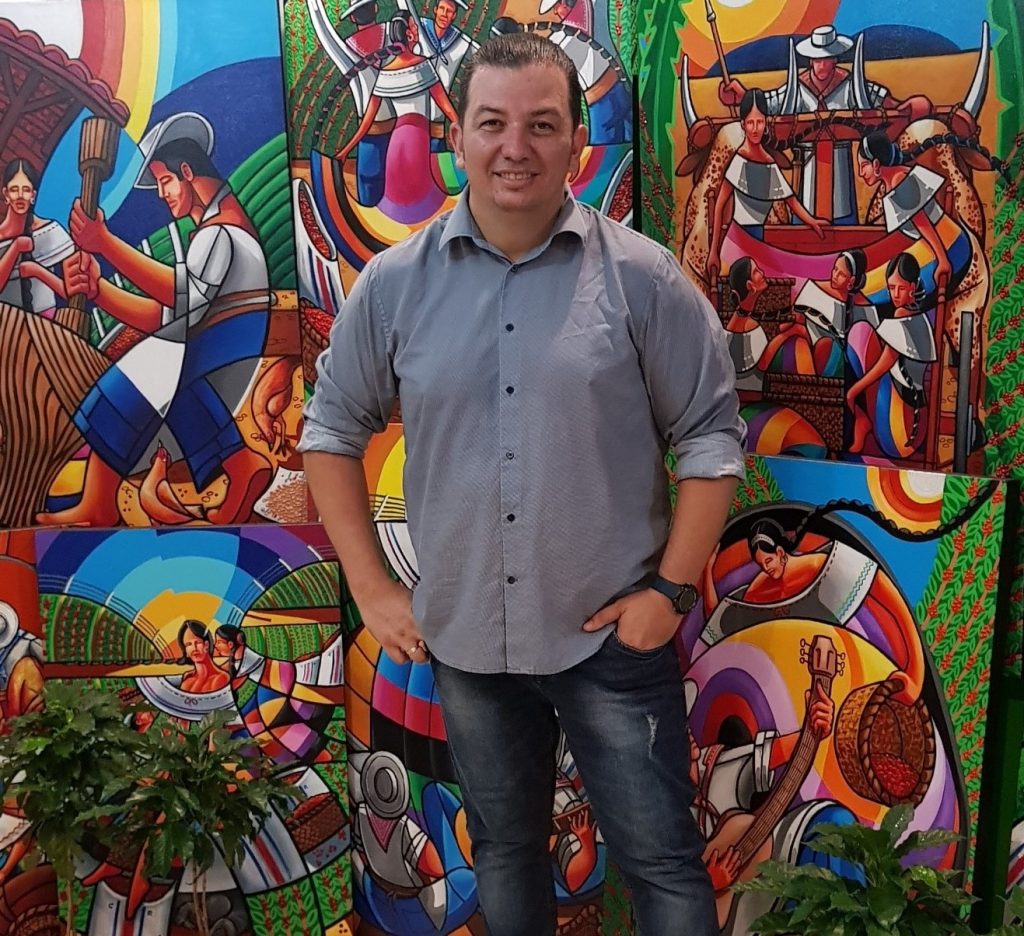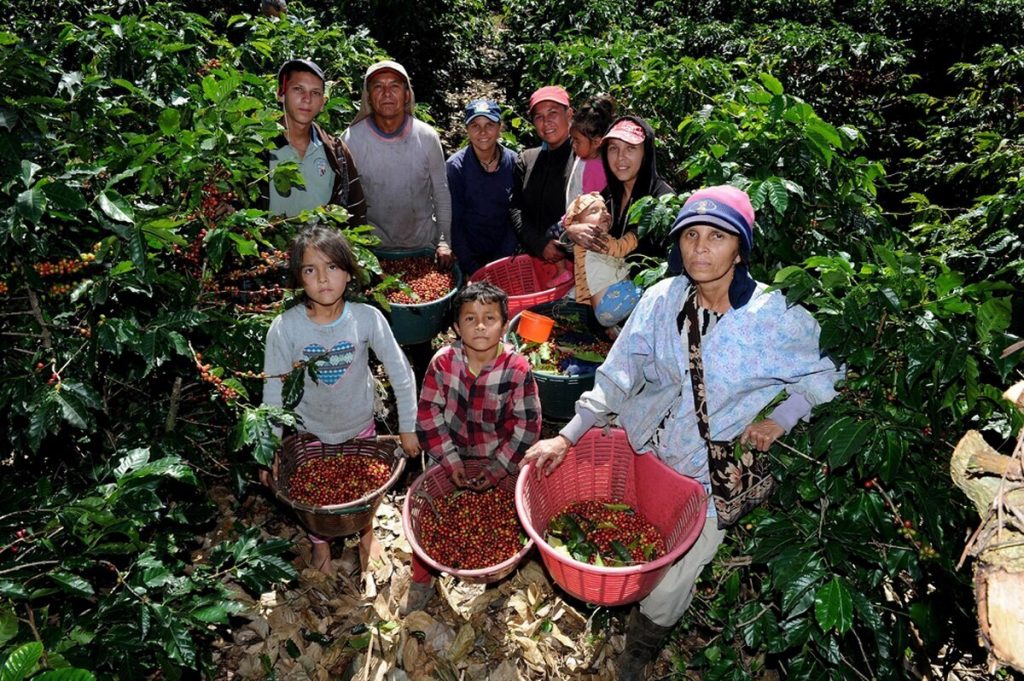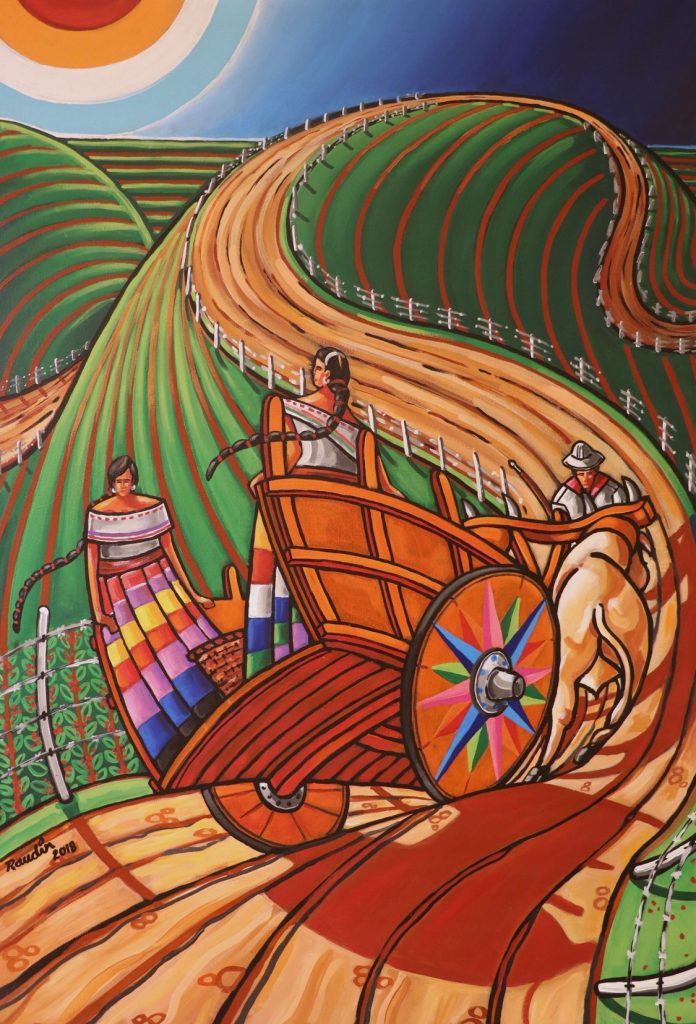Raudyn Alfarto Painter
What made you leave the world of architecture for the art world?
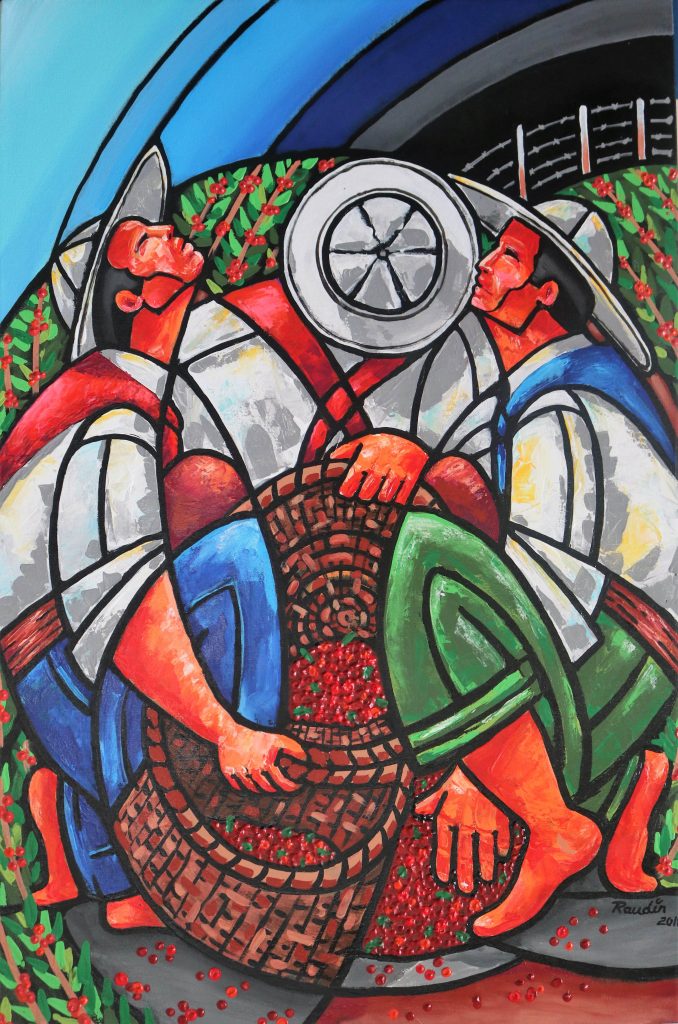
Let’s Gather 2018, 90 x 60cms, Acrylic on Canvas
As the Italian architect Renzo Piano once said, “If you have total freedom, you’re in trouble. It’s much better when you have some obligations, discipline, rules. When you don’t have rules, you start building your own rules.” Every specialty has its rules and regulations to establish in the end parameters of value, in architecture is no exception, creativity is limited in many occasions by the properties of the materials or by the budget of the client; it is also very important to determine your own style that characterizes you before others in this profession. In the art (painting) I have been able to develop my artistic style that within the architecture has limited me for the previous mentioned motives, the acquired architectural concepts and procedures facilitated me to explore and to determine this artistic style within the painting for its environment of neutrality.
Art gives me the freedom to develop compositions using geometric elements such as curves and circles which are difficult in architecture because of their construction in many cases; as an architect and lover of these elements I try to give balance, dynamism, character, foundation and above all intentionality to each work, it is there where the artist I feeds on this knowledge allowing me to develop this new style and at some point also develop it as an architectural style.
Comment on your association (from an early age) with coffee and your art?
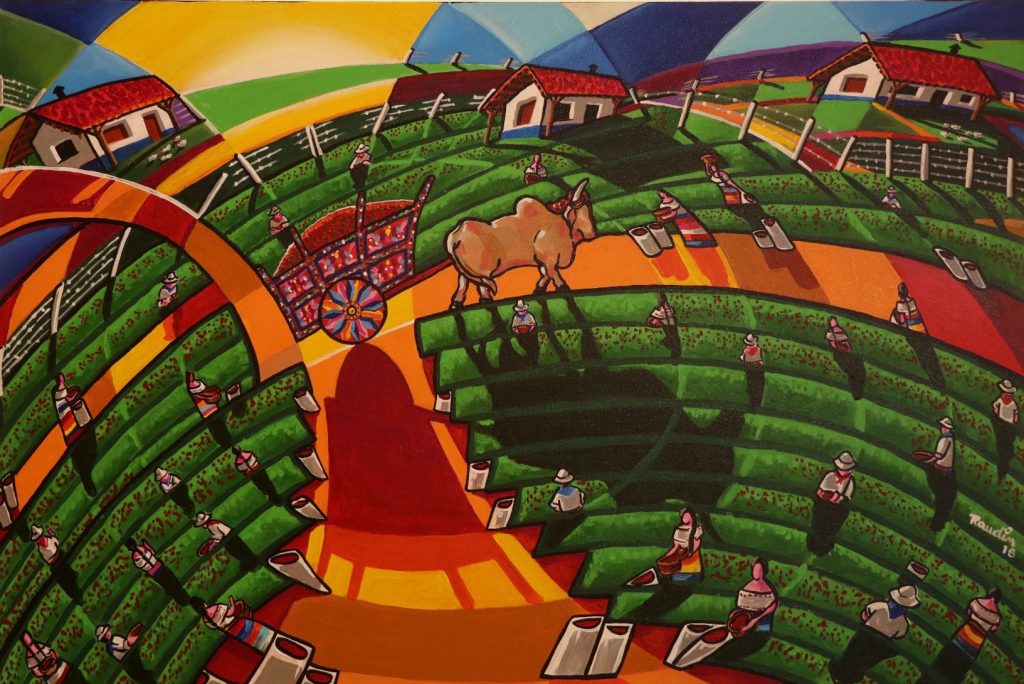
El Callegon, 2017, 90 x 60 cms, Acrylic on canvas
In Costa Rica the time of harvesting the coffee fruit is between the months of December to February (3 months) which also corresponds to the period of school vacations, with it practically all the family was dedicated to this agricultural activity in order to have money for the purchase of gifts at Christmas and school supplies among others, my mother took us from small to the coffee plantations of my hometown Santa Barbara de Heredia where they also congregated multiple families to this activity; this “labor tradition” was becoming through the years in family coexistence within the coffee plantations, the joys, jokes, songs, meals and even the same sadness were shared among all who participated there, all that experience and accumulated memories served me to capture this vision through art firstly as a cultural legacy to my children and all the new generations of my country, because today it has been discontinued in many parts of Costa Rica due to its low profitability for its producers.
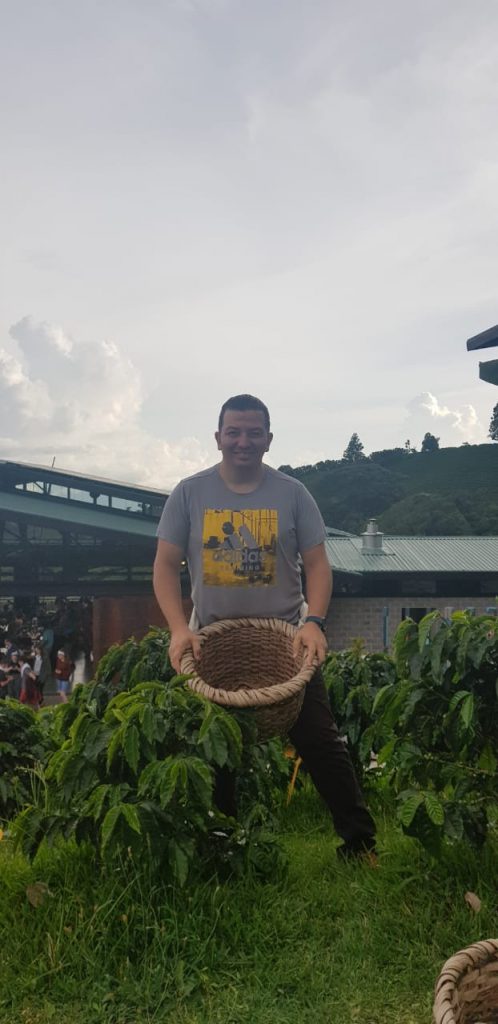
Raudyn Alfarto with the basket ready to collect coffee
The kindness, humility, joviality and responsibility among many other values I learned thanks to this agricultural activity. The history of Costa Ricans has revolved around coffee growing as an economic activity of great transcendence, developing its idiosyncrasy and life, and influencing the development of the model of economic, social and cultural development, basing a “culture with the aroma of the countryside and family pride in its sowing, production and harvest” as when I lived it in past decades in my village.
A family of coffee pickers in Costa Rica
Tell us about your exhibition at the Costa Rican Embassy in Guatemala?
Thanks to the “Declaratory of Cultural Interest” by the Government of Costa Rica and the Ministry of Culture to my art collection entitled “Coffee with a Costa Rican Flavour”, the Embassy of Costa Rica in Guatemala extended to me the invitation to exhibit in that country before the diplomatic community and general public within a period of three months, which consisted of one month at the Embassy of Costa Rica and two months at the Royal Palace of the Captains in Antigua Guatemala.
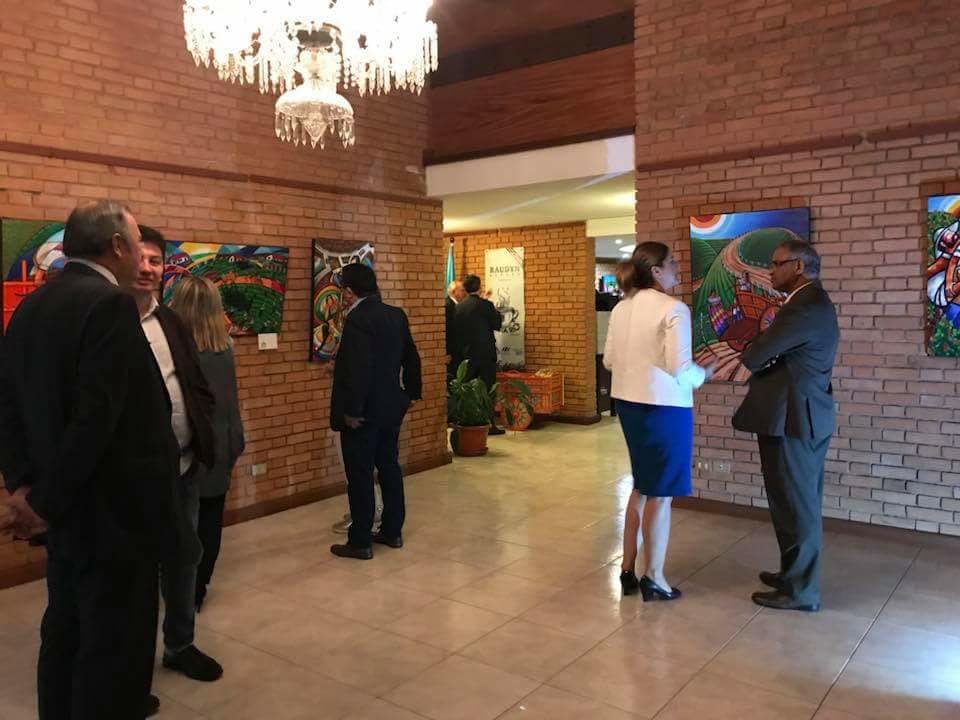
Embassy of Costa Rica in Guatemala
It was my first international experience as a national artist before more than twenty ambassadors from different countries, consuls and heads of commerce; the pride of representing Costa Rica through my art was very high; I felt honored and privileged to receive so many samples of admiration and congratulations for it. They told me how they imaginatively transported them through my work to the time of this agricultural activity in my country, they showed that, through the proper use of geometric figures, the effect of bright colors as well as the hidden perspective achieved that effect.
Discuss who you show ‘hard work’ in your work and why it is so important.
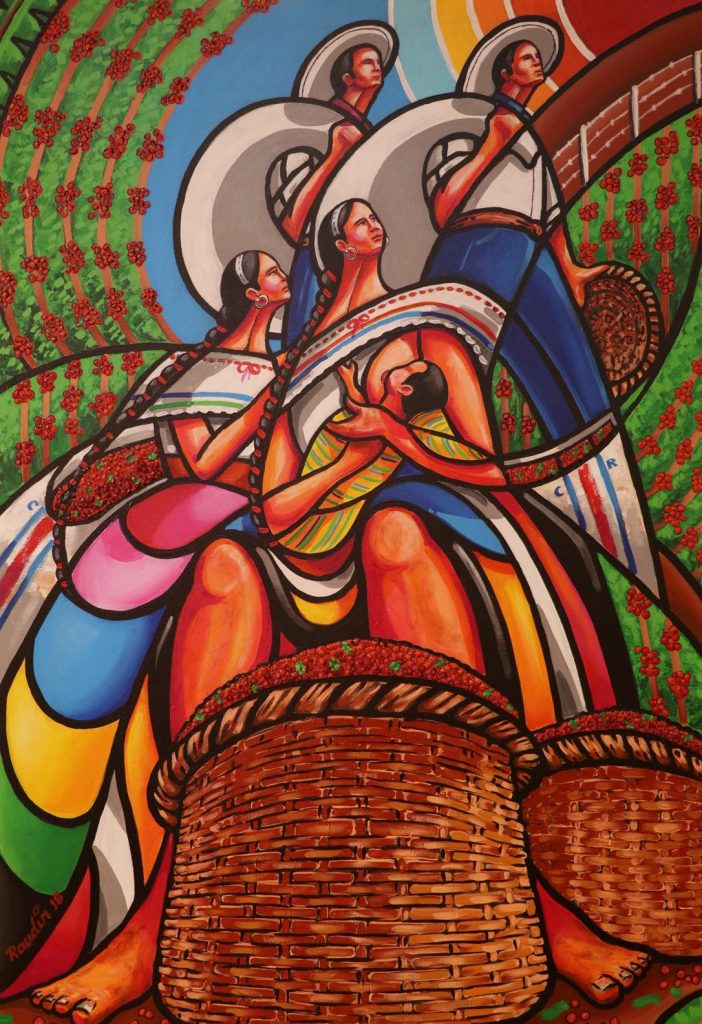
Hard Work, 2018, 110 x 65 cms, Acrylic on canvas
It is the representation of a fact that I observed in my stage of coffee collector, in her I saw a lady who was near me took off her basket to breastfeed her little son who was at her feet, after the baby satiated his hunger the lady returned again to her work as a collector, her husband was near her, but concentrated on the mission of being able to get as much coffee fruit as possible. The double work of this woman made me understand the enormous capacity and dedication in different situations, possibly not being able to count with the time or adequate person for the care of her baby would cause me to take him to his place of work generating this scene of great value; The very perspective of the work transforms it into a sculptural style, where the mother does not lose the other objective that is to return to work without first devoting time to their children, and in a second layer of the painting the representation of her husband and eldest son returning to their work as pickers once deposited the fruit in their respective sacks.
Show one of your paintings in black and white (showing movement and shape) Then show the same work with colour (how the colour transports us to place).
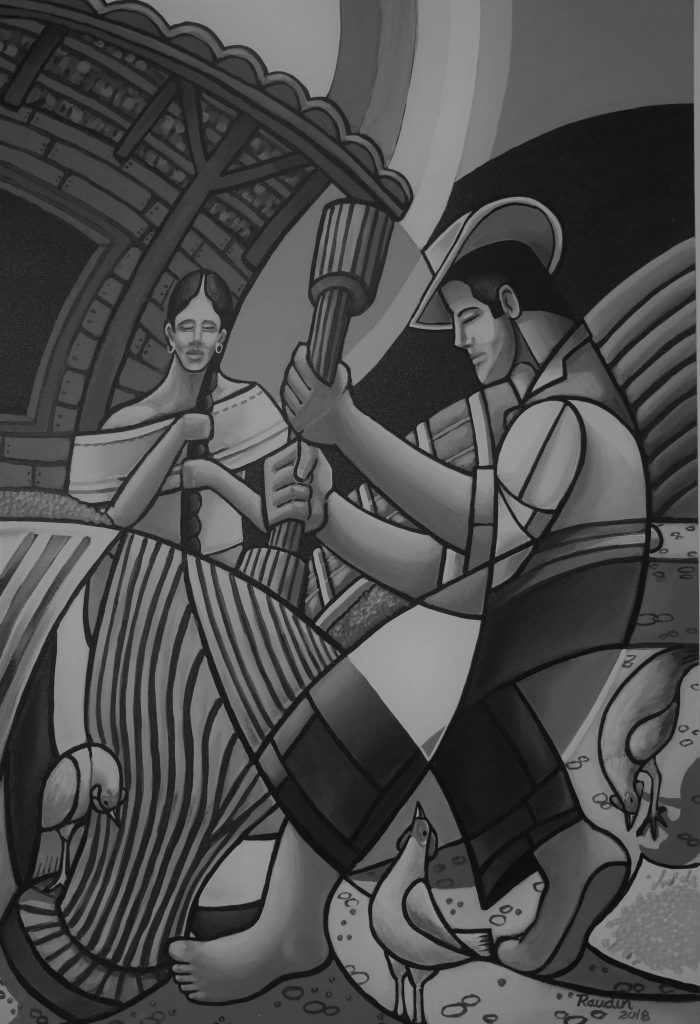
Grinding Coffee, 2018, 110 x 75 cms, Acrylic on canvas
“Color in certain places has the great value of making contours and structural planes seem more energetic”. Antoni Gaudí.
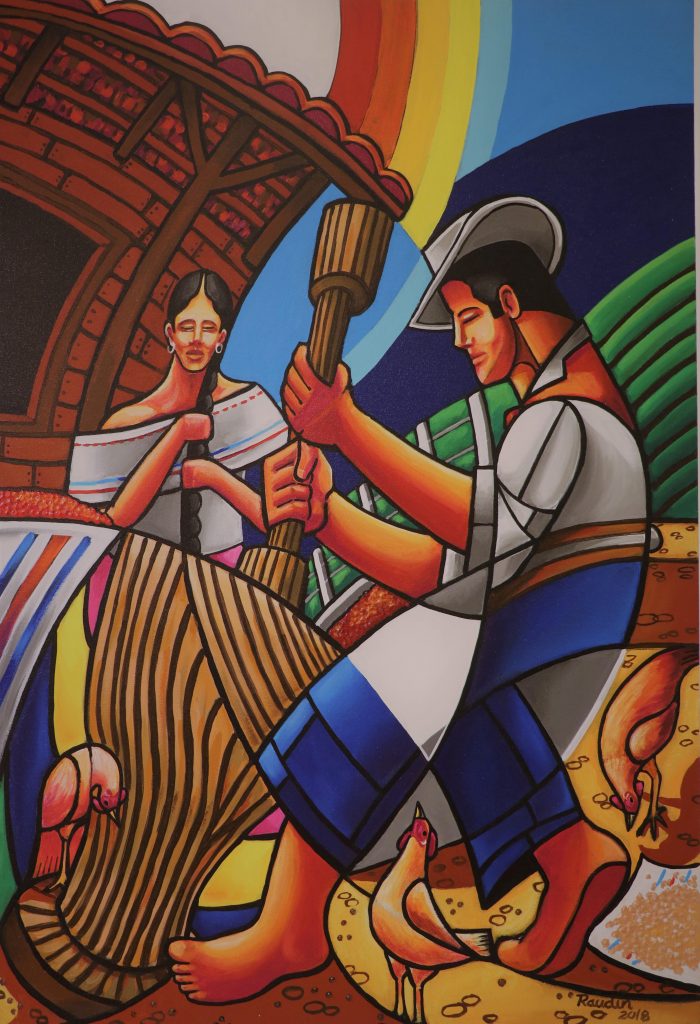
Grinding Coffee, 2018, 110 x 75 cms, Acrylic on canvas
Discuss the people in your work.
Woman:
She is the one who symbolizes in my works and in many occasions the natural beauty, the sublime of a figure, the surrender and determination of intentionality; she is also the one who best represents my country, thanks to her multicolored dresses in honor of our diverse and exuberant. The woman is a symbol of struggle with elegance, hidden tenderness and energy in her movements, it is a painted song that I hear her watching.
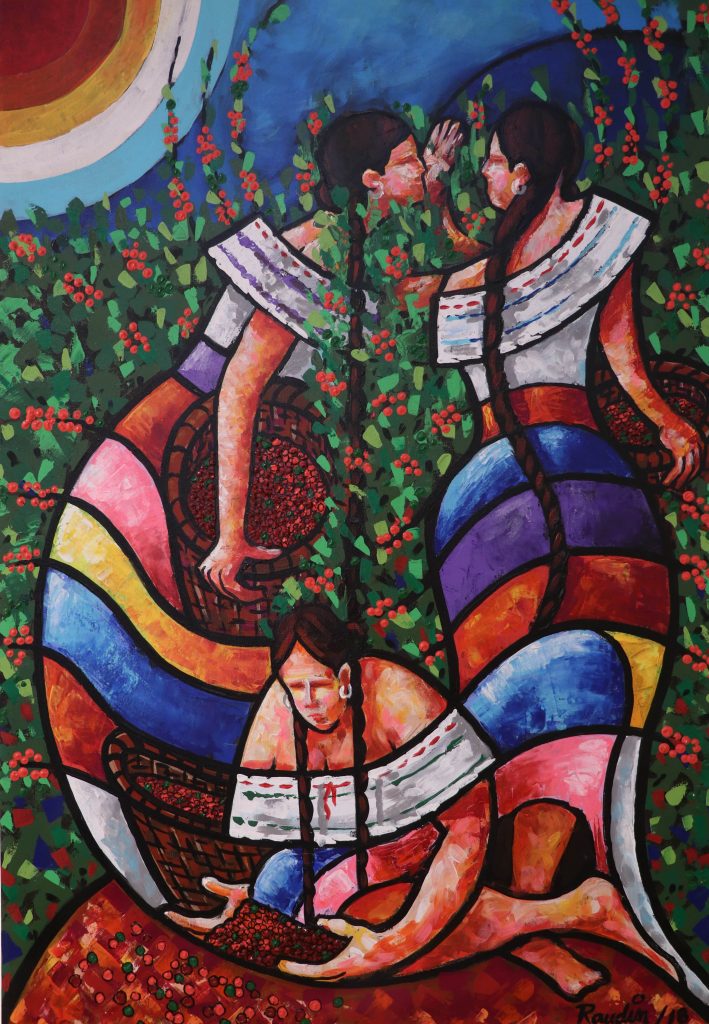
A Gossip in the Plantation, 2018 , 110 x 75 cms, Acrylic on canvas
Man: It is the one that represents the effort, the simple and humble of this population, it also symbolizes the human, that one can fail or stumble, but can also rise again; it is also the image of a rough and badly paid job (coffee picker) if losing in many cases its mischievousness of conqueror.
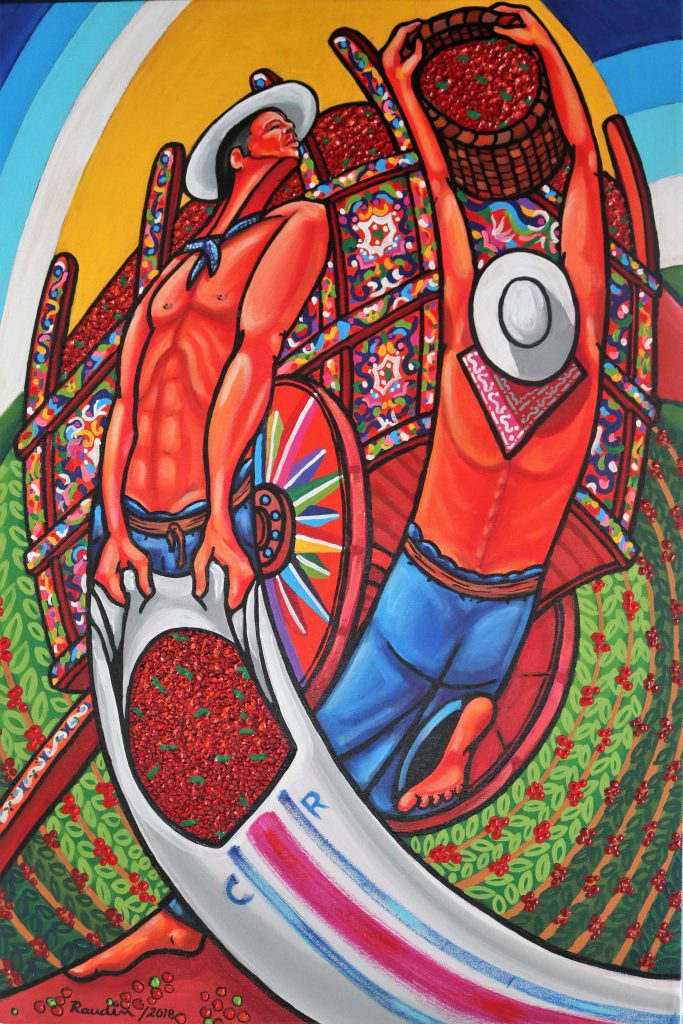
Loading the Cart, 2018, 90 x 60 cms, Acrylic on canvas
Both: They symbolize the union, the love, the commitment; I try not to put prejudices of one on the other, respecting their main human qualities to acquire a symbolic, attractive and intentional balance in my works.
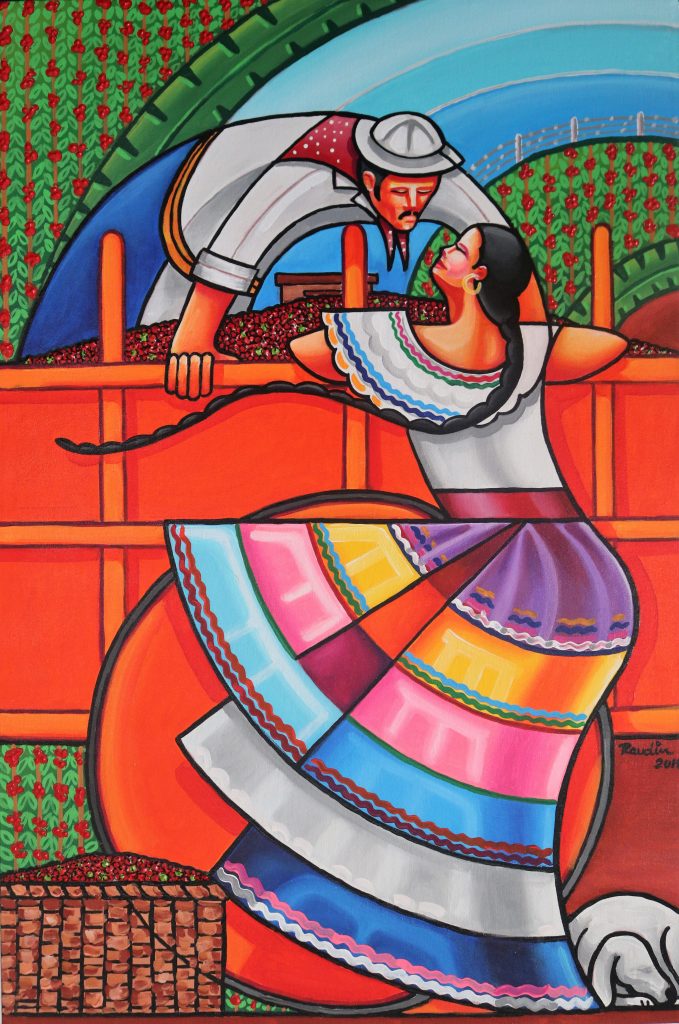
At the Cart, 2018, , 90 x 60 cms, Acrylic on canvas
Can you use one or two of your paintings that show a political aspect? Expand on these works.
“God be with us” is the title of a sketch that I am about to paint; Costa Rica for being a mostly Catholic country since its colonial era, I try to represent the tradition or custom of an entire Costa Rican family in entrusting themselves to their god in an image before leaving home for work (collecting coffee), believing that they will have his protection and blessing for the rest of the day.
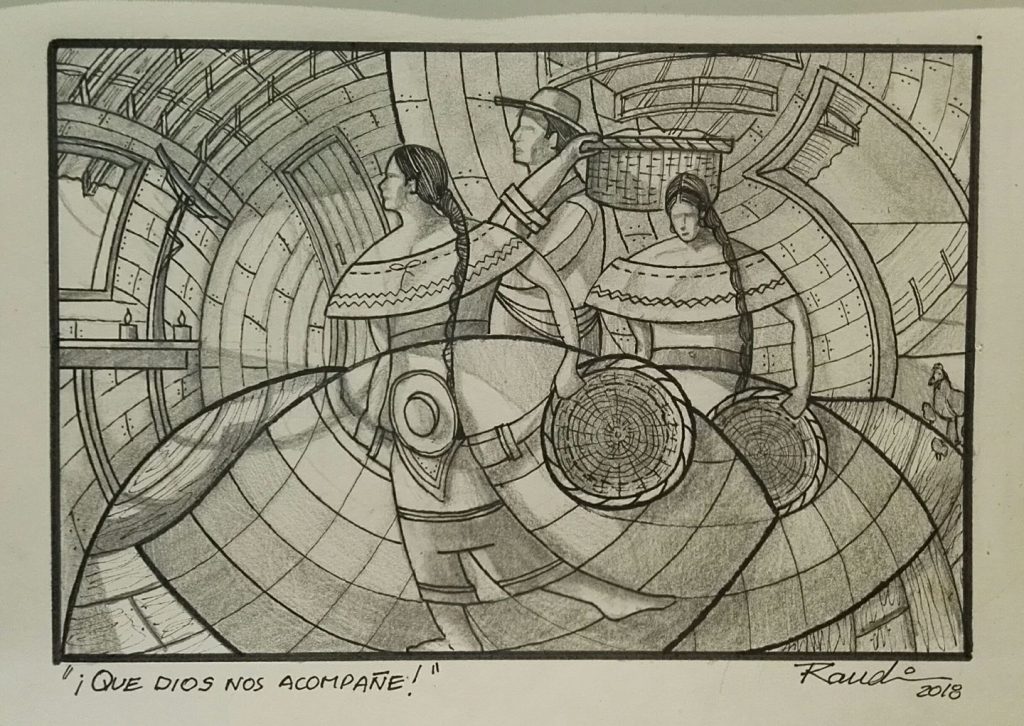
May God be with Us
“On the way home ” is a work that represents the difficult transit of a cart pulled by oxen on the irregular topography of my country, at the sides of the road are observed wire fences limiting coffee plantations, this conformation was given thanks to a political decree of the Government of Costa Rica of the nineteenth century which established the royalty of land dedicated to coffee harvest for a period of five years, due to this new towns and regions were developed throughout the national territory.
Way Home, 2018 , 110 x 75 cms, Acrylic on canvas
Discuss the importance of costume in your work, and how you use it to introduce place.
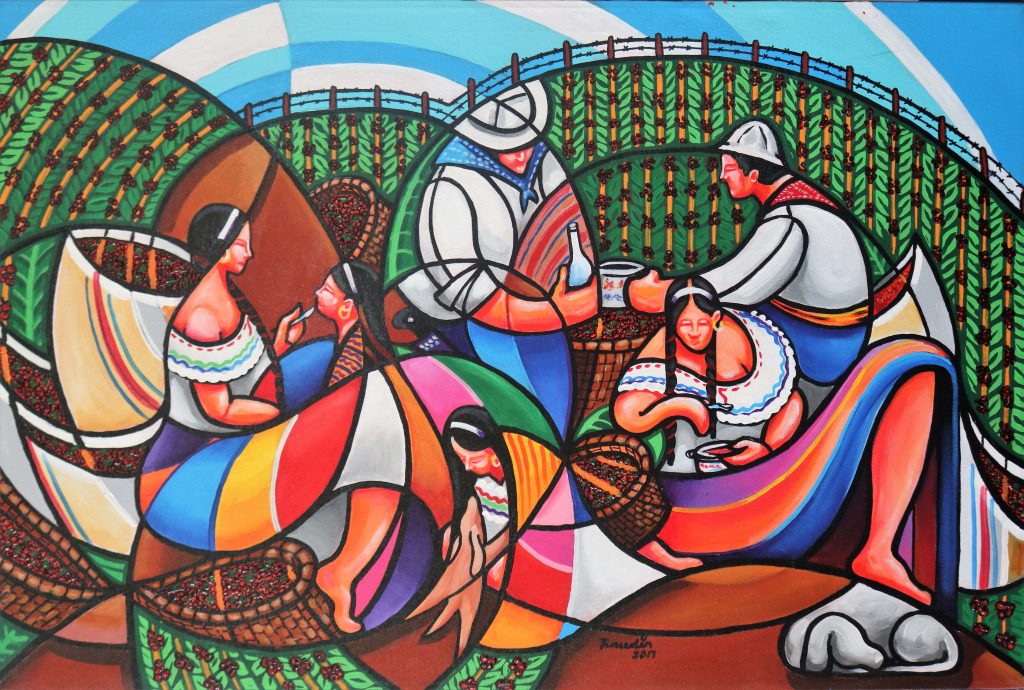
Lunch at the Plantation, 2017 , 90 x 60 cms, Acrylic on canvas
Actually the dresses used for the harvest of the fruit of the coffee differ very much from those proposed in my works, because they are simpler and less colorful; I try to give it a more nationalistic and patriotic character with the use of our typical dresses; The man does not have so much change because his clothing is very similar to that used for agricultural work such as his wide hat, shirt and long pants and a colored scarf on his neck; in a certain way this would be our typical illustration for the world.
Why does costume need colour to show your country?
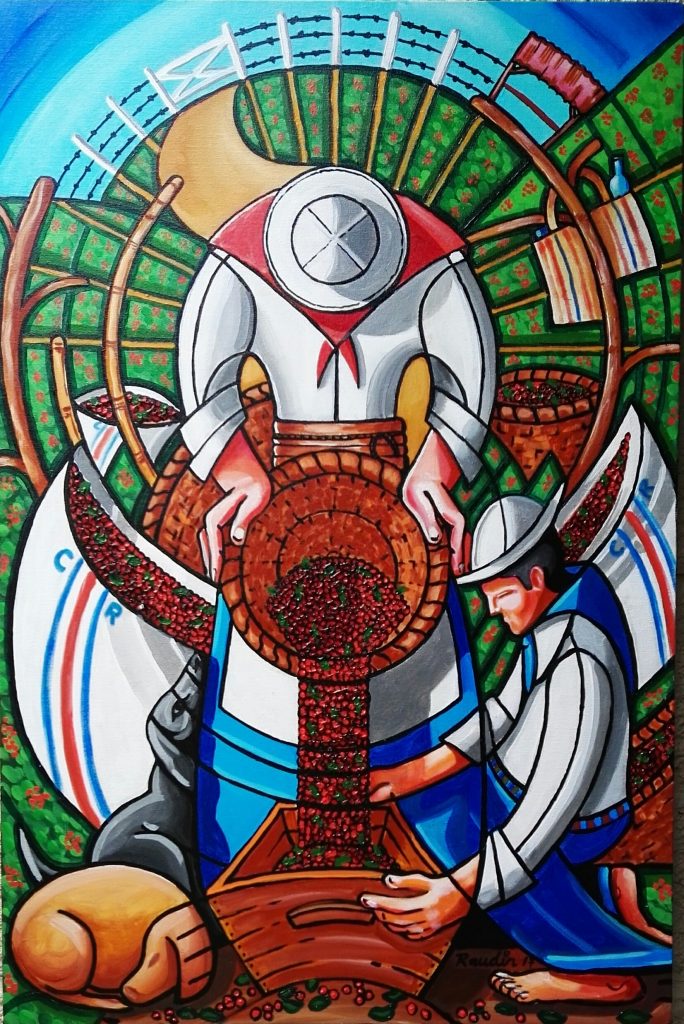
The Basket, 2017 , 90 x 60 cms, Acrylic on canvas
In my country, wherever you look, there is a rich and abundant palette of colors. In the morning until evening, different scenarios are presented before your eyes, all in the same place, passing from cold colors to warm ones and vice versa. From one moment to the next a rainbow appears before you as well as a macaw, a basket of variable fruits as well as a typical picturesque cart, that is to say in Costa Rica they stayed to live all the colors, I can’t and won’t be able to take these off my palette because they are part of our identity. The typical costumes is our letter of representation, as our flag (blue, white and red), blue as the sky that covers us, red for the blood and strength that gave our ancestors and white for peace in these 51,100 square kilometers.
Expand on dance in your work.
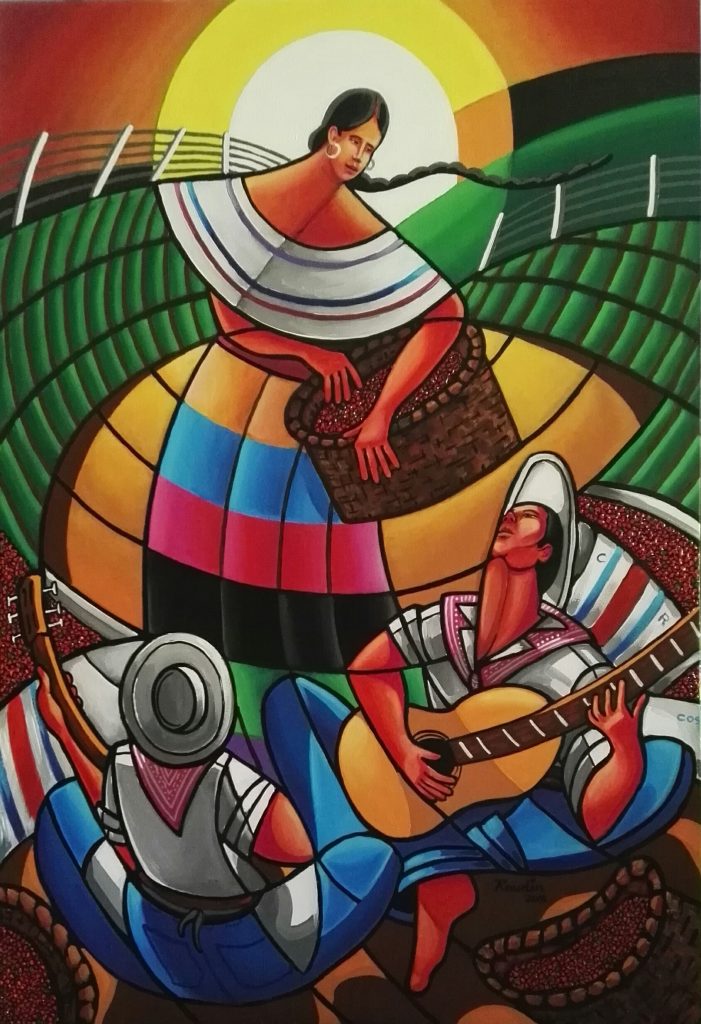
Cantanos Maria, 2018, 110 x 75 cms, Acrylic on canvas
Movement: The movement of the work is generated by curved lines in the lower part of the petticoat intersecting each other and separating the multiple colors; the other point that generates movement is the cyclic of circles that are in the upper part of the work reproducing the silhouettes of the participants, the main straight line is the one that crosses these circles like a radius, conforming the union of the arms in dance. The curve is the line of nature so our brain relates it as something familiar and beautiful, unlike the straight line that produces a state of stillness and solidity to the observer.
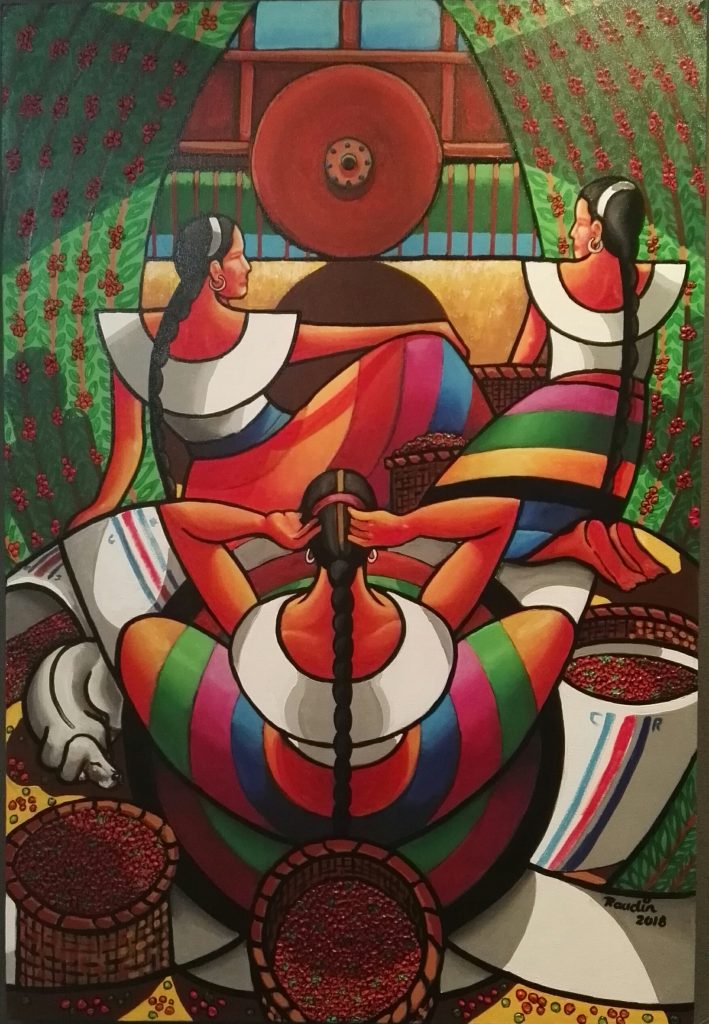
Waiting to Measure, 2018, 110 x 75 cms, Acrylic on canvas
Colors: Based on the theory of color, where harmonic colors are those that work well together, I try to sensitize the observer to perceive a balance in the work, thanks to the neutral color as black to easily separate and locate these colors within the work producing character and intentionality to each of the participating colors, the colors that are always present in my works is the orange that means enthusiasm and exaltation, producing feelings of strength, energy, ambition, determination, joy and triumph.
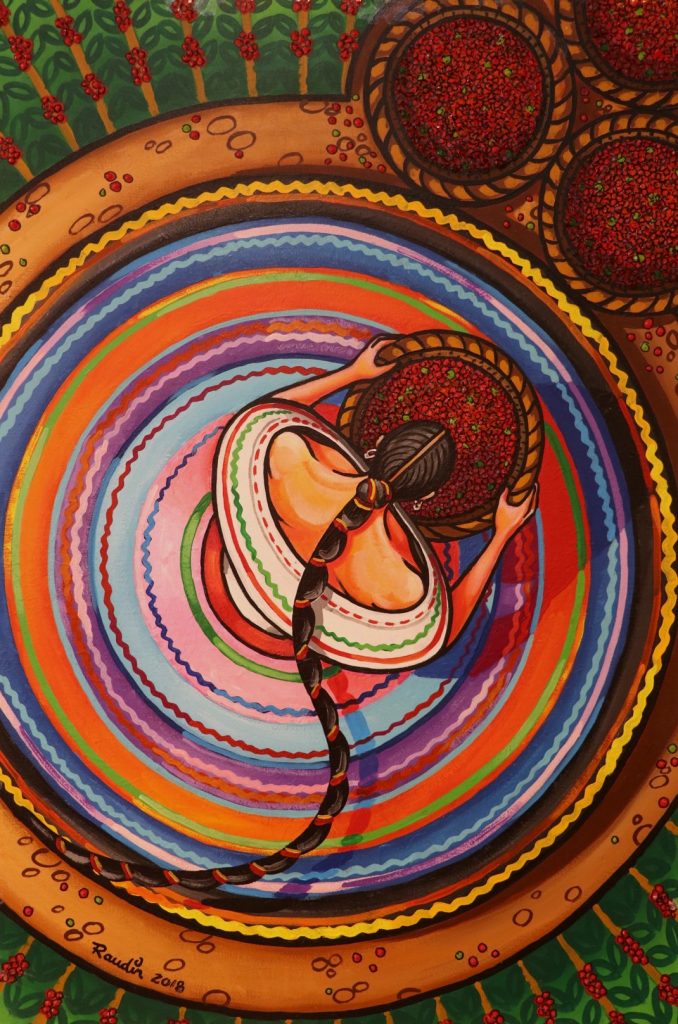
The Cajuela, 2018, 110 x 75 cms, Acrylic on canvas
Grace of the human body: I try to give personality to the human figure by means of the curved line to achieve a posture that reflects its attitude and temperament within the work, that curve must be very subtle sometimes, generating several planes of drawings at the same time, producing that the environment is camouflaged with the human figure and vice versa as mimetism does in architecture with its intonation. A theatrical scene, or like a painted song, is the main intention that I want to transmit to the observer, who shares his emotion just like when he was a coffee picker.
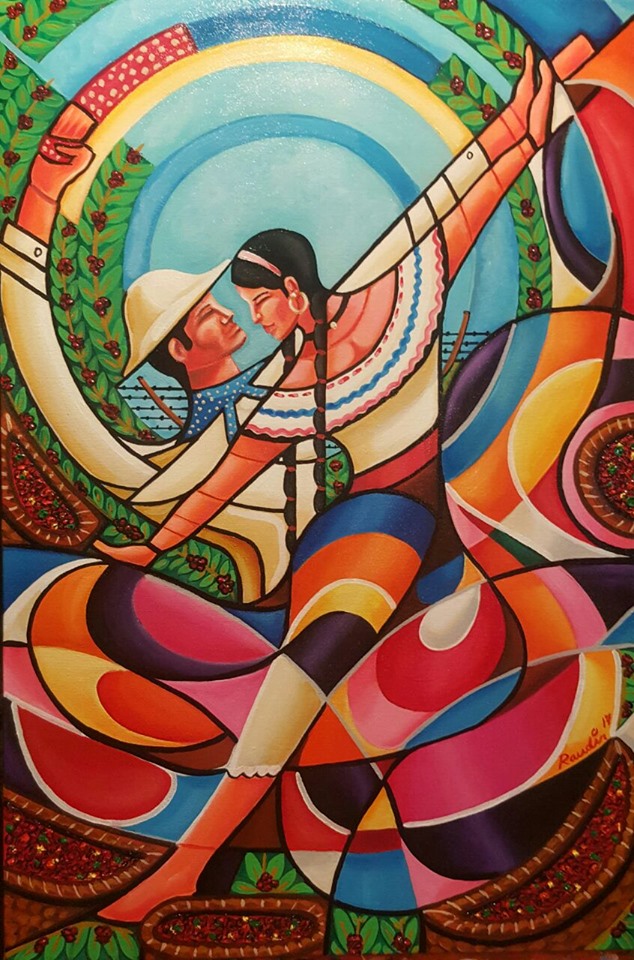
Dancing in the Cafetal, 2017, 90 x 60 cms, Acrylic on canvas
Tradition: In Costa Rica the dance expresses the traditions and customs of our culture, it is a corporal manifestation that in many occasions is to celebrate some festivity, in this occasion they dance inside the plantations of coffee like approval of a good received harvest. Our typical dance is based mainly on circular movements of the women’s petticoats producing a wave of colors for the view, where the shouts of exaltation of both excite all the participants to the dance.
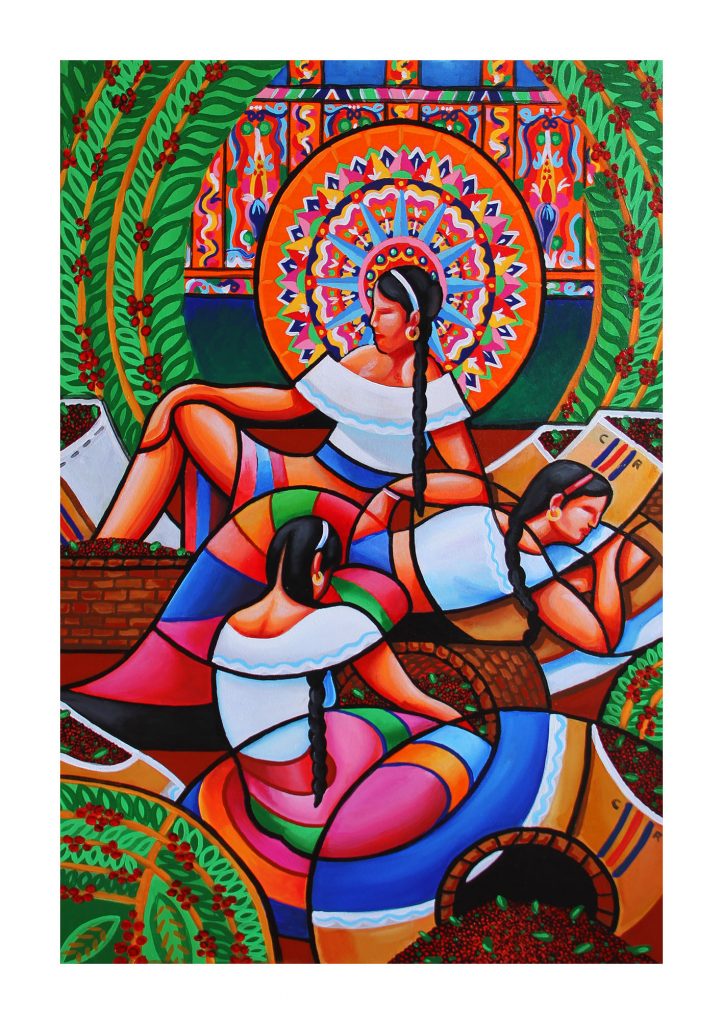
Waiting to Measure II, 2017, 90 x 60 cms, Acrylic on canvas
Intentionality: In my collection “Café con aroma a Costa Rica” it is to be able to relate the qualities of a good coffee like the characteristics that distinguish a Costa Rican; as it is known the coffee of Costa Rica is recognized by its high quality at world-wide level; but I can say the same of our identity; It is easy to recognize a good coffee first by its aroma, then by its body and flavor, so it is possible to distinguish a Costa Rican within a group of people as a coffee literally speaking, of course, because we are happy as the aroma, kind as his body and always leave a sweet taste of our humility, because to be a good Costa Rican has to leave a good taste in the mouth.
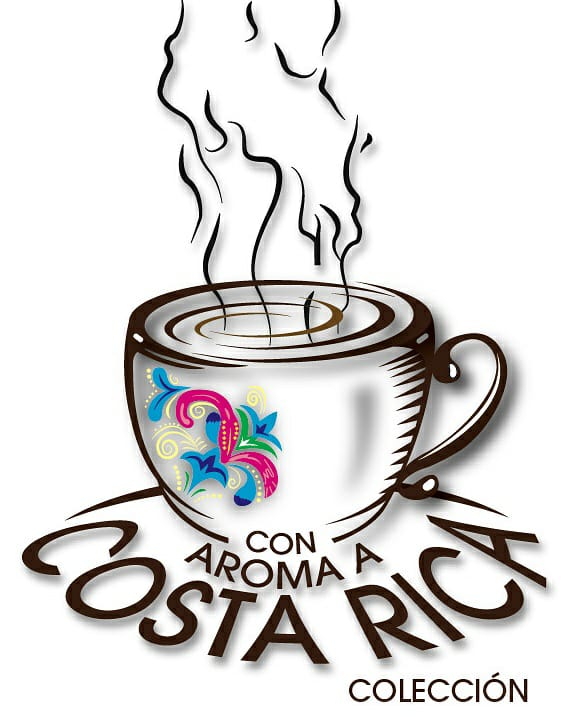
Contact:
Raudyn Alfarto
Raudin Antonio Alfarto Araya
arq.raudyn@gmail.com
www.facebook.com/raudyn.alfarto
Deborah Blakeley, Melbourne, Australia
Interview by Deborah Blakeley, October 2019
Think a colleague or friend could benefit from this interview?
Knowledge is one of the biggest assets in any business. So why not forward this on to your friends and colleagues so they too can start taking advantage of the insightful information the artist has given?
Other artists you may be interested in:


